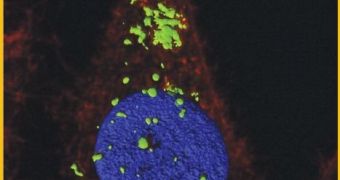Nanoparticles shaped like a disk are the new best way of successfully delivering gene therapy – a treatment aimed at several nucleic acid diseases (DNA or RNA).
The biggest challenge of this method is to have the drug reach its target without losing an important amount along the way, also limiting the undesired side effects.
To do so, the researchers experiment different types of vectors – molecules that are able to safely transport the genetic material to the right place.
The most common method for clinical trials, is to use natural 'deactivated' viruses, but the problem is that their side effects often limit the duration of the therapy.
So, among the few alternatives, one of the most promising ones is the use of artificial viruses, that can be built through the assembly of minute protein structures made up of peptides (the proteins' building blocks).
The leader of the scientists team was Antonio Villaverde, lecturer of the Department of Genetics and Microbiology, researcher at the UAB Institute of Biotechnology and Biomedicine and of the Biomedical Research Networking Center in Bioengineering, Biomaterials and Nanomedicine (CIBER-BBN).
They proved that a certain peptide – theR9, formed by a specific type of amino-acid (arginine) can enclose genetic material, assembly itself with other identical molecules and form nanoparticles that enter directly into the nucleus and release the contained material.
These nanoparticles are shaped like a disk and measure 20 nanometers in diameter and 3 nm in height.
The study was published recently in the journals Biomaterials and Nanomedicine, and it describes the way that the researchers studied the performance of these R9 nanodisks inside the cells.
This was made possible thanks to confocal microscopy techniques, provided by the UAB Microscopy Service and applied by Dr Mònica Roldán.
She explains that, according to the images, once the cell membrane is passed, the particles travel directly to the nucleus at a rate of 0.0044 micrometers per second, which is ten times faster than if they dispersed passively in the interior.
And since the nanoparticles accumulate in the interior of the nucleus and not in the cytoplasm (the thick liquid between the cell membrane and nucleus) their level of effectiveness is much higher.
The discovery of the nanodisks technology is a new way of getting therapeutic benefits from nanoparticles.
Dr Esther Vázquez, the director of the project, said that “nanodisks assemble automatically, move rapidly, remain stable and travel to the interior of the nucleus.
“This makes them a promising tool as a prototype for the safe administration of nucleic acids and functional proteins.”
This discovery was made possible with the help of researchers from the Institute of Material Science of Barcelona (ICMAB-CSIC), the Catalan Institute for Research and Advanced Studies (ICREA), and the Technical University of Catalonia.

 14 DAY TRIAL //
14 DAY TRIAL //